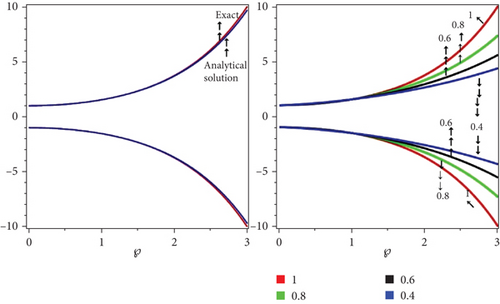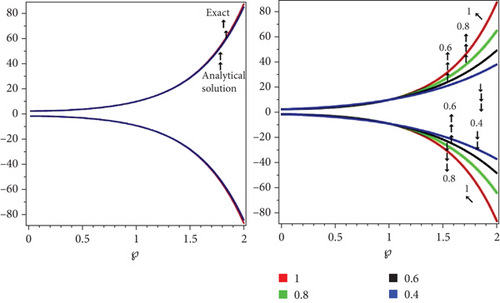Novel Evaluation of Fuzzy Fractional Helmholtz Equations
Abstract
The current article discusses the fuzzy new iterative transform approach, which is a combination of a fuzzy hybrid methodology and an iterative transformation technique. We establish the consistence of our strategy by obtaining fractional fuzzy Helmholtz equations with the initial fuzzy condition using the Caputo derivative under generalized Hukuhara differentiability. The series obtained result was calculated and compared to the proposed equations of the actual result. Three challenges were provided to validate our method, and the outcomes were approximated in fuzzy form. In each of the three examples, the upper and bottom halves of the fuzzy solution were approximated utilizing two various fractional order between 0 and 1. Due to the fact that it globalizes the dynamical behavior of the specified equation, it produces all forms of fuzzy results at any fractional order between 0 and 1. Due to the fact that the fuzzy numbers presents the result in a lower and upper branches fuzzy type, the unknown quantity incorporates fuzziness as well. It is critical to emphasize that the purpose of the proposed fuzziness approach is to demonstrate the efficiency and superiority of numerical solutions to nonlinear fractional fuzzy partial differential equations that arise in complex and physical structures.
1. Introduction
Modeling uncertain issues with the theory of fuzzy sets are a great technique. As a result, fuzzy concepts have been used to model a broad variety of natural events. The fuzzy fractional differential equation, in particular, is frequent models in several scientific domains, such as assessing weapon systems, population models, electrohydraulics, and civil engineering models. As a solution, the fuzzy calculus idea of the fractional derivative is critical [1–4]. As a solution, fractional fuzzy in the domains of mathematics and engineering, differential equations have gotten a lot of attention. The very first is the study by Agarwal et al. [5] devoted to fuzzy fractional differential equations. They established the Riemann-Liouville differentiability concept under the Hukuhara differentiability to analysis fractional fuzzy differential equations [6–8].
Recently, fractional calculus has been offered as a valuable topic to produce precise outcomes of engineering and mathematics issues like signal processing, aerodynamics and control [9–12] systems, biomathematical difficulties, and others. Furthermore, several writers have researched fractional differential equations in fuzzy situations [5], solved using various approaches [13–16]. Hoa investigated fractional fuzzy differential equation under Caputo gH-differentiability in [17]. At the same time, Agarwal et al. conducted a study on the same subject in [18] to highlight its connection to optimal control issues. Long et al. [19] demonstrated the solvability of fractional fuzzy differential problems, while Salahshour et al. [20] solved the issue using Laplace fuzzy transformation.
2. Basic Definition
Definition 1. Consider a continuous function fuzzy on [0, β] ∈ R, we express fractional fuzzy Riemann-Liouvilli integral in the presence of as
Moreover, if , where CF[0, β] is the universe of fuzzy continuous function, and LF[0, β] is the space of continuous fuzzy functions. If the functions are Lebesgue integrable, then the fuzzy fractional integral is given as
Definition 2. For a function , such that and , then the fractional Caputo fuzzy derivative is given as
Definition 3. The Laplace fuzzy transformation for f(℘), where f(℘) is value fuzzy term, is define as
Definition 4. In terms of fuzzy convolution, a fuzzy Laplace transformation is described as
Definition 5. The “Mittag-Leffler function” Eρ(p) is expressed as
Definition 6. Let be a number of fuzzy which have the specified properties
-
κ is an upper semicontinuous number
-
κ{μ(χ1) + μ(χ2)} ≥ min{κ(χ1), κ(χ2)}
-
∃χ0 ∈ R such that κ(χ0) = 1, i.e., v is normal
-
is compact
The set of all fuzzy numbers is represented by the notation E.
Definition 7. The aforementioned number can be written in parametric form as , so that γ ∈ [0, 1] combined with the values
-
from left is continuous and bounded function increasing over [0, 1]
-
from right is continuous and bounded function decreasing over [0, 1]
-
.
3. Main Work with Applications
3.1. Examples
Example 1. Consider fuzzy fractional homogeneous Helmholtz equation with x-space with the fuzzy initial condition
In general, we can write as follows:
Figure 1 shows the fuzzy result comparison for lower and upper branches of Example 1 by Laplace decomposition method. The red color shows that the exact solution of lower and upper branch of fuzzy solution at integer order and second cure shows the analytical solution of example 1. In Figure 1, second graph shows two dimensional figure of fuzzy result at four other various fractional order of ρ of Example 1. The two similar color legends represent lower and upper portions of fuzzy solution, respectively.
Example 2. Consider fuzzy fractional homogeneous Helmholtz equation with x-space with the fuzzy initial condition
In general, we can write as follows:
The exact result is

Figure 2 shows the fuzzy result comparison for lower and upper branches of Example 1 by Laplace decomposition method. The red color shows that the exact solution of lower and upper branch of fuzzy solution at integer order and second cure shows the analytical solution of Example 2. In Figure 2, second graph shows two dimensional figure of fuzzy result at four other various fractional order of ρ of Example 2. The two similar color legends represent lower and upper portions of fuzzy solution, respectively.
Example 3. Consider fuzzy fractional homogeneous Helmholtz equation with x-space with the fuzzy initial condition
In general, we can write as follows:
The exact result is

Figure 3 shows the fuzzy result comparison for lower and upper branches of Example 1 by the Laplace decomposition method. The red color shows that the exact solution of lower and upper branch of fuzzy solution at integer order and second cure shows the analytical solution of Example 3. In Figure 3, second graph shows two dimensional figure of fuzzy result at four other various fractional order of ρ of Example 3. The two similar color legends represent lower and upper portions of fuzzy solution, respectively.

4. Conclusion
The aim of this paper was to propose a semianalytic solution to the fractional fuzzy Helmholtz equations using the Caputo derivative. An significant example has verified the solution achieved. We have also included plots of the analytical solution at various fractional orders. As seen in the graphs, when the fractional order nu approachs its integer value, the graphs will similar with the curve at integer order 1. Our study has shown that fractional calculus can identify the global nature of equations that are associated with fuzzy concepts. As future research continues, we will apply this approach to models with more dynamic features. In the future, this technique can be used to derive analytic and approximation solutions to perturbed fractional differential equations with fractional and classical initial conditions in the sense of the Caputo operator.
Conflicts of Interest
The authors declare that there are no conflicts of interest regarding the publication of this article.
Open Research
Data Availability
The numerical data used to support the findings of this study are included within the article.




